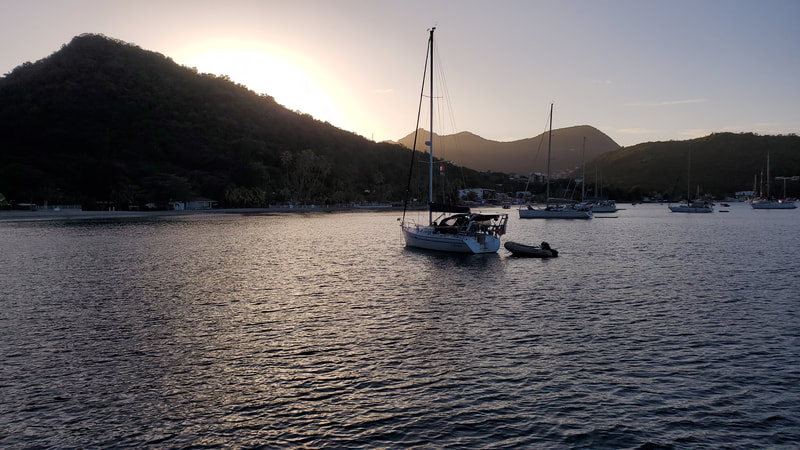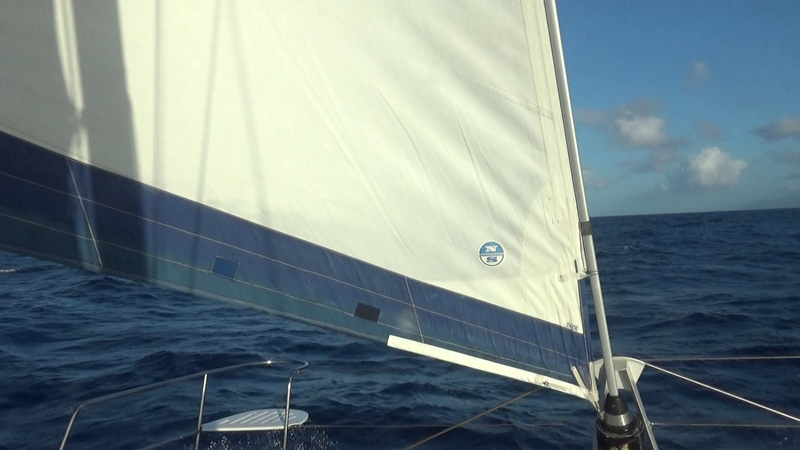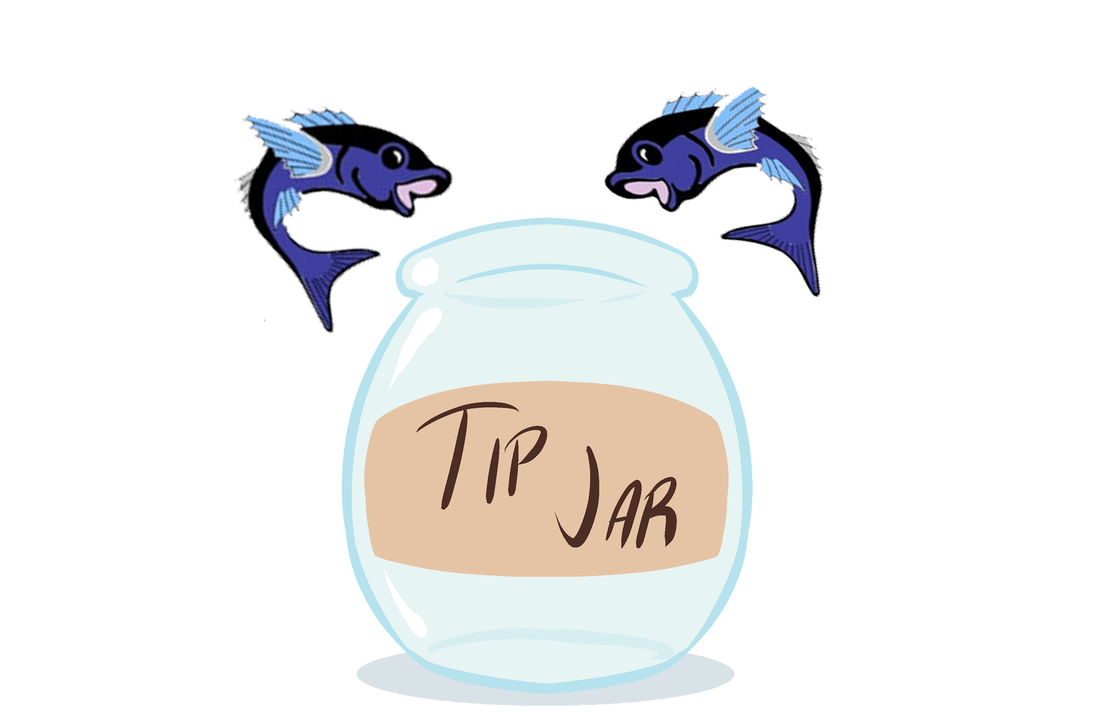We departed Grande Anse as the first rays of sunshine were breaking over the lush tropical hilltops surrounding the bay. The winds hadn’t picked up yet as we motored past S/V Smitty enjoying their morning coffee. As we made our way out of the lee of the hills the wind filled in ever so slightly. We raised the main and turned North to Anse Turin. We would have liked to have the Genoa out as well, but it had ripped on our passage to Martinique.
The anchorage at Saint Pierre was fairly crowded and it took us a few minutes to find a good spot to set our anchor. Arriving to a new anchorage is always a little time consuming. You have to find the best spot that is a good balance between being close to the tender dock so you can easily get to shore, but not so close that you and 30 of your closest friends all choose the same spot.
We were just getting set when our friends from S/V Smitty and S/V Sea Ya! were arriving. Once everyone was settled we took a short walk through Saint Pierre for a drink and bite to eat. Saint Pierre was founded in 1635 and is a beautiful seaside city that has been designated a “City of Art and History”. Like most islands in the Caribbean, Martinique was formed from volcanic action. In 1902 the city of Saint Pierre was totally destroyed by the eruption of Mount Pelee. Only two people survived the eruption. If you have ever heard the story of the lone prisoner that survived a volcano, that is this story. Louis-Auguste Cyparis was the lucky one that survived the total destruction of the city. That is an interesting story all on its own.
The next morning Lisa and I pulled the genoa down. We were finally ready to tackle the rips we made leaving the USVI. We moved the Sailrite LSZ-1 onto the bow and started stitching the UV cover. The UV cover protects the sail from sunlight when it is furled. The actual sail material isn’t very resistive to UV light so another fabric, like Sunbrella, is usually affixed to the last 12-18 inches of a sail. The seams failed and started flapping in the wind. Since the sail was already down we also took the time to patch up a couple places that were getting a little chaffe.
A few hours later we were making the walk up to the De Paz Rum distillery. De Paz is just over three kilometers from the tender dock, but it is uphill the entire way. Luckily we were going up before the sun started really beating down on us. The Distillery sits at the foot of Mounte Pelee. DePaz produces an agricole rum from crushing fresh sugar cane. After the eruption of 1902 the grounds were rebuilt in 1917 and the distillery has been making tasty rum ever since. Visitors can do a self guided tour to see old watermills that still function. The red walking path takes you through some of the previously used buildings like the turbine room. The tour ends in the gift shop where you are offered free tastings of their delicious rum concoctions. The rum really is reasonably priced here as well. As we traveled to other places after this visit I took note of the prices around the Caribbean. I suggest stocking up here on whichever rum you enjoy. You’ll be glad you did.
Be sure to check back next time when we take a quick stop in Dominica before heading off to Les Saints.
The anchorage at Saint Pierre was fairly crowded and it took us a few minutes to find a good spot to set our anchor. Arriving to a new anchorage is always a little time consuming. You have to find the best spot that is a good balance between being close to the tender dock so you can easily get to shore, but not so close that you and 30 of your closest friends all choose the same spot.
We were just getting set when our friends from S/V Smitty and S/V Sea Ya! were arriving. Once everyone was settled we took a short walk through Saint Pierre for a drink and bite to eat. Saint Pierre was founded in 1635 and is a beautiful seaside city that has been designated a “City of Art and History”. Like most islands in the Caribbean, Martinique was formed from volcanic action. In 1902 the city of Saint Pierre was totally destroyed by the eruption of Mount Pelee. Only two people survived the eruption. If you have ever heard the story of the lone prisoner that survived a volcano, that is this story. Louis-Auguste Cyparis was the lucky one that survived the total destruction of the city. That is an interesting story all on its own.
The next morning Lisa and I pulled the genoa down. We were finally ready to tackle the rips we made leaving the USVI. We moved the Sailrite LSZ-1 onto the bow and started stitching the UV cover. The UV cover protects the sail from sunlight when it is furled. The actual sail material isn’t very resistive to UV light so another fabric, like Sunbrella, is usually affixed to the last 12-18 inches of a sail. The seams failed and started flapping in the wind. Since the sail was already down we also took the time to patch up a couple places that were getting a little chaffe.
A few hours later we were making the walk up to the De Paz Rum distillery. De Paz is just over three kilometers from the tender dock, but it is uphill the entire way. Luckily we were going up before the sun started really beating down on us. The Distillery sits at the foot of Mounte Pelee. DePaz produces an agricole rum from crushing fresh sugar cane. After the eruption of 1902 the grounds were rebuilt in 1917 and the distillery has been making tasty rum ever since. Visitors can do a self guided tour to see old watermills that still function. The red walking path takes you through some of the previously used buildings like the turbine room. The tour ends in the gift shop where you are offered free tastings of their delicious rum concoctions. The rum really is reasonably priced here as well. As we traveled to other places after this visit I took note of the prices around the Caribbean. I suggest stocking up here on whichever rum you enjoy. You’ll be glad you did.
Be sure to check back next time when we take a quick stop in Dominica before heading off to Les Saints.







 RSS Feed
RSS Feed

